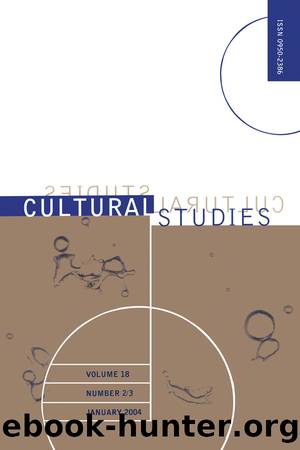Cultural Studies Vol18 Issue 2 by Various Authors

Author:Various Authors [Authors, Various]
Language: eng
Format: epub
Tags: Nonfiction, Social & Cultural Studies, Social Science
ISBN: 9781000446128
Publisher: Taylor and Francis
Published: 2021-12-24T05:00:00+00:00
However appealing such a vision is, both Lefebvre and Willis ultimately provide little with which to recover routine for aesthetic attention. And that is because for both of them aesthetics is already a term of value. As such, the ambiguous and devalued experience of routine would fit awkwardly into such an approach. However far they both want to extend the remit of aesthetics, their understanding of aesthetics is governed in advance by already established categories of art (and art appreciation).
In a similar way, the extension ofâaestheticsâ to include representation more generally and âstyleâ more particularly, is also, for my purposes at least, limited. For instance, in his wide-ranging essay âPostmodernism and the aestheticization of everyday lifeâ, Featherstone (1992) suggests three significant domains for recognizing the aestheticization of the everyday. First off, he suggests that the âhistoric avant-gardesâ (by this he mainly refers to Dada, surrealism and the Soviet avant-gardes of the 1910s and 1920s) sought âto efface the boundary between art and everyday lifeâ (Featherstone 1992, p. 268). Such a project continues into more recent history, for example, in the work of Pop Art. Such avant-garde subcultures refused to inhabit the specialized and transcendent realm of the institution ofâfine artâ: the museum, the academy, the connoisseurship of an elite, its striving for beauty and sophistication. Such an account of avant-gardism is also the overriding argument that Bürger (1984) provides in his Theory of the Avant-Garde. Featherstoneâs second example of the aestheticization of everyday life is the life lived aesthetically. His example is, of course, Oscar Wilde, but any number of artists or celebrities would do. The precariousness of this category is marked by its extension into the present with the notion ofâlife styleâ. As such the aestheticization of daily life in terms of fashion, design, food, music, etc. must be seen as at the heart of the modern everyday. As soon as we make choices about clothes or the colour of a room, we are part of an aestheticization of daily life. Elizabeth Wilson in her recent study of bohemianism (Wilson 2000) provides an excellent resource for critically extending this argument: in many ways the very aestheticizing practices of Bohemianism bring with them a practical criticism that challenges the ideological normalcy of everyday life (its regulation of sexuality, regimes of work and leisure, and so on). For Featherstone, âthe third sense of the aestheticization of everyday life refers to the rapid flow of signs and images which saturate the fabric of everyday life in contemporary societyâ (1992, p. 270). Clearly, this points to the intensification of mass-media forms and would include everything from newspapers to cinema, from billboards to road signs.
Featherstoneâs essay is a diagnosis of modernity and postmodernity, his project is to trace some of the ways that âstylizationâ has penetrated everyday life. Indeed if one were to swap the word âstyleâ for âaestheticsâ in his essayâs title nothing much would be lost. It is the way that social life invests in the outward garb of representation, stylized into a variety of looks that is the central topic.
Download
This site does not store any files on its server. We only index and link to content provided by other sites. Please contact the content providers to delete copyright contents if any and email us, we'll remove relevant links or contents immediately.
The Kite Runner by Khaled Hosseini(4430)
Bloody Times by James L. Swanson(3979)
The Mayflower and the Pilgrims' New World by Nathaniel Philbrick(3911)
Pocahontas by Joseph Bruchac(3721)
Flesh and Blood So Cheap by Albert Marrin(3394)
An American Plague by Jim Murphy(3367)
For the Love of Europe by Rick Steves(3190)
The 101 Dalmatians by Dodie Smith(2933)
Hello, America by Livia Bitton-Jackson(2720)
Finding Gobi by Dion Leonard(2259)
Harry Potter and the Half-Blood Prince (hp-6) by J. K. Rowling(2139)
The Impossible Rescue by Martin W. Sandler(1971)
See You in the Cosmos by Jack Cheng(1820)
I Will Always Write Back by Martin Ganda(1763)
Bloody Times: The Funeral of Abraham Lincoln and the Manhunt for Jefferson Davis by James L. Swanson(1723)
The Queen of Attolia by Megan Whalen Turner(1697)
When Dimple Met Rishi by Sandhya Menon(1679)
The Crossover by Kwame Alexander(1621)
Hoodoo by Ronald L. Smith(1574)
